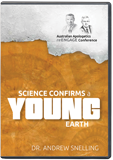
Creationists Are Liars? Finding Adam in the Genome with BioLogos
In this web article series so far, you will have already read a thorough scientific defense of the young-earth creation (YEC) position on Adam and Eve. In doing so, you might have been amazed at the compelling scientific case for the literal, historical existence of Adam and Eve.
However, if you’ve also read Dennis Venema’s chapters in Adam and the Genome,1 you might have found them to be similarly persuasive—for the opposite view. In the first four chapters of his book, Venema makes the scientific case for the theistic evolutionary position on Adam and Eve—that humanity does not descend from one sole original couple, but rather from a population of individuals.
These two books might leave you in a bit of a dilemma. If you’re like most people, you’re not a geneticist. Consequently, since the level of scientific detail in this debate is so deep, you might wonder if making an informed decision is impossible. How can a layperson navigate this maze?
One of the previous posts in this series contains a clue to the answer. In that post, we dealt with the question of why so many scientists disagree with YEC science. We claimed that evolutionists don’t agree with us because they don’t bother to read our literature.
Evolutionists don’t agree with us because they don’t bother to read our literature.
Venema’s book chapters provide an opportunity to test this hypothesis. If you examine not only his chapter text but also his endnotes, you’ll discover that Venema makes virtually no attempt to engage what YEC scientists have published. Aside from a few references to one self-proclaimed YE creationist’s personal blog, and a reference to an outdated YEC paper,2 all the published claims from our book chapter are given no treatment in Venema’s book.
I don’t mean that Venema failed to interact with the chapter itself. Given the few months that separated the publication times of our book and his, this endeavor would have been nearly impossible. Rather, Venema failed to interact with any of the previously published papers and published articles3 on which our book chapter was based. Some of these papers have been available for over three years.4 Since Venema’s book was published just a few months ago, Venema simply decided not to engage our literature.
This observation is consistent with our claim that evolutionists refuse to read our literature.
But why do evolutionists ignore the technical writings of YEC scientists? Consider the few YEC statements and references that Venema did include in his chapters: those that agreed with Venema’s claims. In other words, the only YEC literature that found its way into Venema’s writing were claims that underscored the points that Venema was making. Any YEC data and statements that contradicted Venema’s claims were absent.
In other words, it appears that Venema fits facts to his preconceived conclusions. Data and facts from YEC scientists that contradicted his claims were left out. (Contrast this to our book chapter—see here, here, here, and here—where we repeatedly interacted with opposing views; see also the technical YEC papers referenced therein, which underscore this pattern even more strongly.)
Why might Venema—and other evolutionists for that matter—do this? Consider Venema’s opinion of his YEC opponents. Naturally, since Venema doesn’t discuss his YEC opponents openly, we can infer it only from his statements about the one YEC scientist whom he favorably cites. Regarding this scientist’s 2006 paper, Venema says that “it is unique among the young-earth literature in that it is thoroughly accurate and does not misrepresent the data”5 (emphasis mine).
What does this statement imply about the rest of the YEC literature? It implies that scientists like Jeff Tomkins and myself are misrepresenting the data and being scientifically inaccurate.
Consider another statement by Venema regarding the one YEC scientist whom he favorably cites. This particular YEC individual agreed with Venema on the supposedly overwhelming scientific evidence for evolution. Venema said that this person was “just being honest about the state of the evidence for evolution”6 (emphasis mine).
This time, what does Venema’s admission imply about the rest of the YEC literature, especially the literature that contradicts Venema’s position on evolution? Based on his own words, Venema thinks that other YEC scientists are being dishonest about the scientific evidence.
For some readers, these discoveries might come as a shock. After all, Venema writes for an organization (BioLogos) that claims to be committed to “humility and gracious dialogue with those who hold other views”7 (emphasis theirs). Regular readers of BioLogos and of the BioLogos Forum will be well-acquainted with how much BioLogos boasts of their stated commitment. Conversely, Venema’s accusations against people like myself might seem to contradict this stated commitment.
Venema isn’t unique in his opinions of YEC scientists. The BioLogos managing editor, Brad Kramer, wrote an article8 summarizing an invited, public exchange that I had with Darrel Falk at a meeting of the Evangelical Theological Society. On the BioLogos Forum, Kramer’s post generated over one hundred comments,9 and Kramer moderated the comments and interacted with them. One of the commenters described me as “dishonest” and claimed that my scientific work “borders on fraud” and “can be harmful to society.”10 Yet Kramer never interacted with him or corrected him. Why not?
At the top of the BioLogos Forum page, the heading reads, “This is a place for gracious dialogue about science and faith.” The FAQ page instructs participants to “focus on discussing other people’s ideas, not on evaluating their character, faith, communication style, or perceived ‘tone.’”11 Why was this rule not enforced for this commenter? Could it be because the BioLogos staff agrees with him? My own personal correspondence with Jim Stump, senior editor at BioLogos, suggests that the answer is yes.
Consider another example. The American Scientific Affiliation (ASA) is “an international network of Christians in the sciences.”12 One of their former presidents, Randy Isaac, has been a member of the BioLogos Advisory Council. He recently made a statement similar to the ones that Venema has made:
The oft-stated [ASA] policy not to take a position in areas of honest disagreement among Christians is an extremely important aspect that characterizes ASA. It is also a most difficult one to maintain. For one thing, it is not easy to differentiate an honest disagreement from a dishonest one. My personal preference, though not an official ASA position, was that the reference for honest disagreements was the accepted consensus view of the scientific community.13 (emphasis mine)
In other words, according to Isaac, disagreement itself can be a form of dishonesty.
Now apply Isaac’s statement to evolution. The “accepted consensus view of the scientific community” is that evolution is a fact. To argue that evolution is not a scientific fact is, according to Isaac, a form of dishonest disagreement. In other words, simply disagreeing with evolution is a form of lying.
Venema’s views are prevalent in the theistic evolutionary community.
Thus, it should be no surprise that Venema fits facts to conclusions. He believes that his YEC opponents are liars. Therefore, he sees no need to engage their scientific claims—regardless of how persuasive the evidence might be.
To clarify, I’m not saying that evolutionists like Venema know YEC science to be the correct scientific explanation, but then ignore it in order to buttress their preferred (i.e., evolutionary) view of origins. Rather, I’m saying that people like Venema genuinely believe that YEC scientists are liars. Therefore, it’s no surprise that they make no effort to explore the data that YEC scientists publish.
These observations set the stage for the web articles that will follow. In subsequent posts, we will be exploring Venema’s contribution to Adam and the Genome in a chapter-by-chapter manner. Yet, even before we dive into the complex genetic details, we already know where this discussion will be headed: we’re going to find that Venema fits scientific facts to his evolutionary conclusions.
This is pseudoscience, not science.
YE creationists have presented a compelling scientific case for their position and have engaged the rejoinders and arguments of their opponents. . . . Evolutionists ignore their YEC opponents.
Let’s return to the dilemma with which we began this article: in the debate over the existence of Adam and Eve, how can a layperson adjudicate the competing scientific claims? We now have a clear answer. On one side of the debate, YE creationists have presented a compelling scientific case for their position and have engaged the rejoinders and arguments of their opponents. (Again, for justification, see the previous posts in this series.) On the other side of the debate, evolutionists ignore their YEC opponents. They view disagreement with evolutionary science as tantamount to lying. Thus, they fit scientific data to their predetermined conclusions. In other words, YEC scientists practice the scientific method; evolutionists don’t.
This is a strong claim. Strong claims demand strong support. Consequently, I don’t expect you to take my word for it. Instead, I challenge readers to examine the evidence that will be documented in subsequent posts in this series. I think you’ll soon see that my claims are backed by abundant evidence from Venema’s book.
Footnotes
Dennis R. Venema and Scot McKnight, Adam and the Genome: Reading Scripture After Genetic Science, Grand Rapids, MI: Brazos Press, 2017.
The paper is over 10 years old. While older scientific literature can be accurate, this particular paper has been thoroughly refuted in the subsequent YEC technical literature (for example, see J. P. Tomkins, “Documented Anomaly in Recent Versions of the BLASTN Algorithm and a Complete Reanalysis of Chimpanzee and Human Genome-Wide DNA Similarity Using Nucmer and LASTZ,” Answers Research Journal 8 (2015): 379–390; and J. P. Tomkins, “Analysis of 101 Chimpanzee Trace Read Data Sets: Assessment of Their Overall Similarity to Human and Possible Contamination With Human DNA,” Answers Research Journal 9 (2016): 294–298)—literature which Venema never cites.
-
Some examples:
N. T. Jeanson, “Recent, Functionally Diverse Origin for Mitochondrial Genes from ~2700 Metazoan Species. Answers Research Journal 6 (2013): 467–501, https://answersingenesis.org/genetics/mitochondrial-dna/recent-functionally-diverse-origin-for-mitochondrial-genes-from-~2700-metazoan-species/.
N. T. Jeanson, “Mitochondrial DNA Clocks Imply Linear Speciation Rates Within ‘Kinds,’” Answers Research Journal 8 (2015): 273–304, https://answersingenesis.org/natural-selection/speciation/clocks-imply-linear-speciation-rates-within-kinds/.
N. T. Jeanson, “A Young-Earth Creation Human Mitochondrial DNA ‘Clock’: Whole Mitochondrial Genome Mutation Rate Confirms D-loop Results,” Answers Research Journal 8 (2015): 375–378, https://answersingenesis.org/genetics/mitochondrial-genome-mutation-rate/.
N. T. Jeanson, “On the Origin of Human Mitochondrial DNA Differences, New Generation Time Data Both Suggest a Unified Young-Earth Creation Model and Challenge the Evolutionary Out-of-Africa Model,” Answers Research Journal 9 (2016): 123–130, https://answersingenesis.org/genetics/mitochondrial-dna/origin-human-mitochondrial-dna-differences-new-generation-time-data-both-suggest-unified-young-earth/.
N. T. Jeanson and J. Lisle, “On the Origin of Eukaryotic Species’ Genotypic and Phenotypic Diversity: Genetic Clocks, Population Growth Curves, and Comparative Nuclear Genome Analyses Suggest Created Heterozygosity in Combination with Natural Processes as a Major Mechanism,” Answers Research Journal 9 (2016): 81–122, https://answersingenesis.org/natural-selection/speciation/on-the-origin-of-eukaryotic-species-genotypic-and-phenotypic-diversity/.
J. P. Tomkins, “Genome-Wide DNA Alignment Similarity (Identity) for 40,000 Chimpanzee DNA Sequences Queried Against the Human Genome Is 86–89%,” Answers Research Journal 4 (2011): 233–241, https://answersingenesis.org/genetics/dna-similarities/genome-wide-dna-alignment-similarity-identity-for-40000-chimpanzees/.
J. P. Tomkins, “Comprehensive Analysis of Chimpanzee and Human Chromosomes Reveals Average DNA Similarity of 70%,” Answers Research Journal 6 (2013): 63–69, https://answersingenesis.org/answers/research-journal/v6/comprehensive-analysis-of-chimpanzee-and-human-chromosomes/.
J. P. Tomkins, “The Human Beta-Globin Pseudogene Is Non-Variable and Functional,” Answers Research Journal 6 (2013): 293–301, https://answersingenesis.org/genetics/human-genome/the-human-beta-globin-pseudogene-is-non-variable-and-functional/.
J. P. Tomkins, “Alleged Human Chromosome 2 ‘Fusion Site’ Encodes an Active DNA Binding Domain Inside a Complex and Highly Expressed Gene—Negating Fusion,” Answers Research Journal 6 (2013): 367–375, https://answersingenesis.org/genetics/dna-similarities/alleged-human-chromosome-2-fusion-site-encodes-an-active-dna-binding-domain-inside-a-complex-and-hig/.
J. P. Tomkins, “Comparison of the Transcribed Intergenic Regions of the Human Genome to Chimpanzee,” CRSQ 50 (2014): 212–221, https://www.creationresearch.org/comparison-of-the-transcribed-intergenic-regions-of-the-human-genome-to-chimpanzee.
J. P. Tomkins, “Challenging the BioLogos Claim that a Vitellogenin (Egg-Laying) Pseudogene Exists in the Human Genome,” Answers Research Journal 8 (2015): 403–411, https://answersingenesis.org/genetics/dna-similarities/challenging-biologos-claim-vitellogenin-pseudogene-exists-in-human-genome/.
J. P. Tomkins, “Documented Anomaly in Recent Versions of the BLASTN Algorithm and a Complete Reanalysis of Chimpanzee and Human Genome-Wide DNA Similarity Using Nucmer and LASTZ,” Answers Research Journal 8 (2015): 379–390, https://answersingenesis.org/genetics/dna-similarities/blastn-algorithm-anomaly/.
J. P. Tomkins, “Analysis of 101 Chimpanzee Trace Read Data Sets: Assessment of Their Overall Similarity to Human and Possible Contamination With Human DNA,” Answers Research Journal 9 (2016): 294–298, https://answersingenesis.org/genetics/dna-similarities/analysis-101-chimpanzee-trace-read-data-sets-assessment-their-overall-similarity-human-and-possible/.
J. P. Tomkins and J. Bergman, “The Chromosome 2 Fusion Model of Human Evolution—Part 2: Re-analysis of the Genomic Data,” Journal of Creation 25, no. 2 (2011): 111–117, http://creation.com/chromosome-2-fusion-2.
J. Tomkins and J. Bergman, “Genomic Monkey Business—Estimates of Nearly Identical Human-Chimp DNA Similarity Re-evaluated Using Omitted Data,” Journal of Creation 26, no. 1 (2012): 94–100, http://creation.com/human-chimp-dna-similarity-re-evaluated.
J. P. Tomkins and J. Bergman, “Evolutionary Molecular Genetic Clocks—a Perpetual Exercise in Futility and Failure,” Journal of Creation 29, no. 2 (2015): 26–35, http://creation.com/images/pdfs/tj/j29_2/j29_2_26-35.pdf.
J. Bergman and J. Tomkins, “The Chromosome 2 Fusion Model of Human Evolution—Part 1: Re-evaluating the Evidence,” Journal of Creation 25, no. 2 (2011):106–110, http://creation.com/chromosome-2-fusion-1.
J. Bergman and J. Tomkins, “Is the Human Genome Nearly Identical to Chimpanzee?—a Reassessment of the Literature,” Journal of Creation 26, no. 1 (2012): 54–60, http://creation.com/human-chimp-dna-similarity-literature.
N. T. Jeanson, “Human-Chimp Genetic Similarity: Do Shared ‘Mistakes’ Prove Common Ancestry?” Acts & Facts 40, no. 9 (2011): 6, http://www.icr.org/article/human-chimp-genetic-similarity-do-shared.
N. T. Jeanson, “Does ‘Junk DNA’ Exist?” Acts & Facts 42, no. 4 (2013): 20, http://www.icr.org/article/does-junk-dna-exist.
N. T. Jeanson, “Does ‘Homology’ Prove Evolution?” Acts & Facts 42, no. 9 (2013): 20, http://www.icr.org/article/does-homology-prove-evolution.
N. T. Jeanson, “New Genetic-Clock Research Challenges Millions of Years,” Acts & Facts 43, no. 4 (2014): http://www.icr.org/article/8017/.
N. T. Jeanson, “Darwin vs. Genetics: Surprises and Snags in the Science of Common Ancestry,” Acts & Facts 43, no. 9 (2014): http://www.icr.org/article/darwin-vs-genetics-surprises-snags/.
For example, N. T. Jeanson, “Recent, Functionally Diverse Origin for Mitochondrial Genes from ~2700 Metazoan Species,” Answers Research Journal 6 (2013): 467–501, https://answersingenesis.org/genetics/mitochondrial-dna/recent-functionally-diverse-origin-for-mitochondrial-genes-from-~2700-metazoan-species/.
Venema, Adam and the Genome, 203.
- Ibid., 41.
“About Us,” BioLogos, http://biologos.org/about-us/our-mission/.
Brad Kramer, “5 Common Objections to Evolutionary Creationism,” BioLogos, November 30, 2015, http://biologos.org/blogs/brad-kramer-the-evolving-evangelical/5-common-objections-to-evolutionary-creationism.
System, November 30, 2015, 10:06 a.m., comment on Brad Kramer, “5 Common Objections to Evolutionary Creationism,” BioLogos, November 30, 2015, https://discourse.biologos.org/t/5-common-objections-to-evolutionary-creationism/3498/1.
Patrick, December 1, 2015, (11:22 a.m.), comment on Brad Kramer, “5 Common Objections to Evolutionary,” The BioLogos Forum, https://discourse.biologos.org/t/5-common-objections-to-evolutionary-creationism/3498/28.
“FAQ/Guidelines,” The BioLogos Forum, https://discourse.biologos.org/t/faq-guidelines/5.
“About the ASA,” The American Scientific Affiliation, http://network.asa3.org/?page=ASAAbout#Who%20we%20are.
Christopher M. Rios, “An Interview with Randy Isaac, ASA Executive Director, 2005–2016,” Perspectives on Science and Christian Faith 68, no. 3 (September 2016): 193.
Recommended Resources

Answers in Genesis is an apologetics ministry, dedicated to helping Christians defend their faith and proclaim the good news of Jesus Christ.
- Customer Service 800.778.3390
- © 2024 Answers in Genesis






